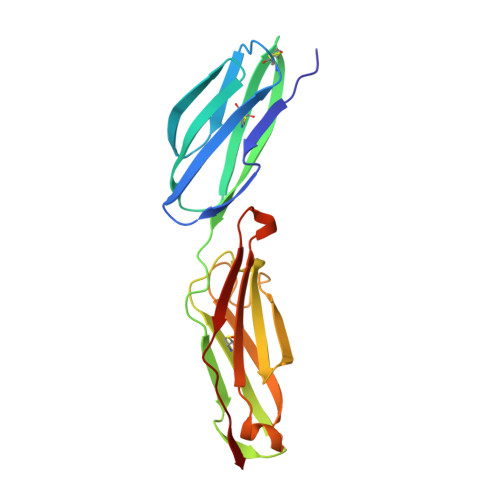Crystal structure of ICAM-2 reveals a distinctive integrin recognition surface.
Casasnovas, J.M., Springer, T.A., Liu, J.H., Harrison, S.C., Wang, J.H.(1997) Nature 387: 312-315
- PubMed: 9153399
- DOI: https://doi.org/10.1038/387312a0
- Primary Citation of Related Structures:
1ZXQ - PubMed Abstract:
Recognition by integrin proteins on the cell surface regulates the adhesive interactions between cells and their surroundings. The structure of the 'I' domain that is found in some but not all integrins, has been determined. However, the only integrin ligands for which structures are known, namely fibronectin and VCAM-1, are recognized by integrins that lack I domains. The intercellular adhesion molecules ICAM-1, 2 and 3 are, like VCAM-1, members of the immunoglobulin superfamily (IgSF), but they are recognized by an I domain-containing integrin, lymphocyte-function-associated antigen 1 (LFA-1, or CD11a/CD18). Here we present the crystal structure of the extracellular region of ICAM-2. The glutamic acid residue at position 37 is critical for LFA-1 binding and is proposed to coordinate the Mg2+ ion in the I domain; this Glu 37 is surrounded by a relatively flat recognition surface and lies in a beta-strand, whereas the critical aspartic acid residue in VCAM-1 and fibronectin lie in protruding loops. This finding suggests that there are differences in the architecture of recognition sites between integrins that contain or lack I domains. A bend between domains 1 and 2 of ICAM-2 and a tripod-like arrangement of N-linked glycans in the membrane-proximal region of domain 2 may be important for presenting the recognition surface to LFA-1. A model of ICAM-1 based on the ICAM-2 structure provides a framework for understanding its recognition by pathogens.
- The Center for Blood Research, Harvard Medical School, Department of Pathology, Boston, Massachusetts 02115, USA.
Organizational Affiliation:

















